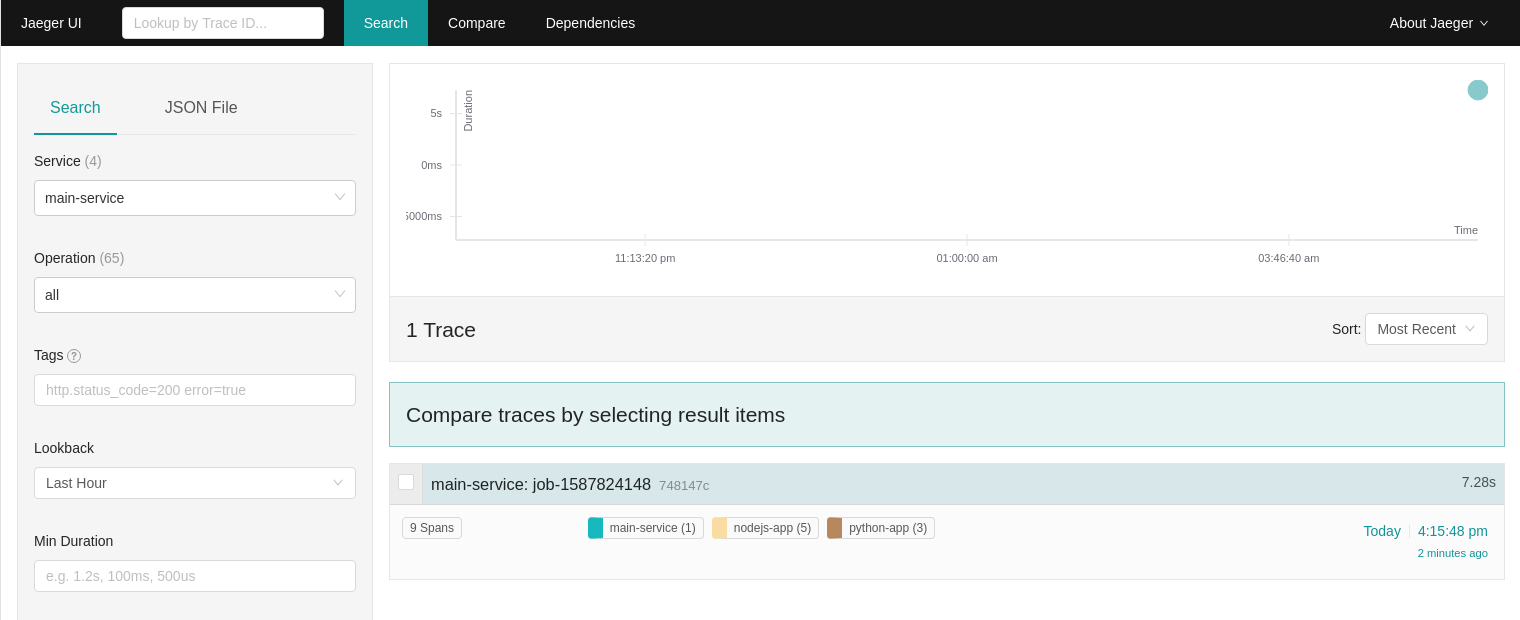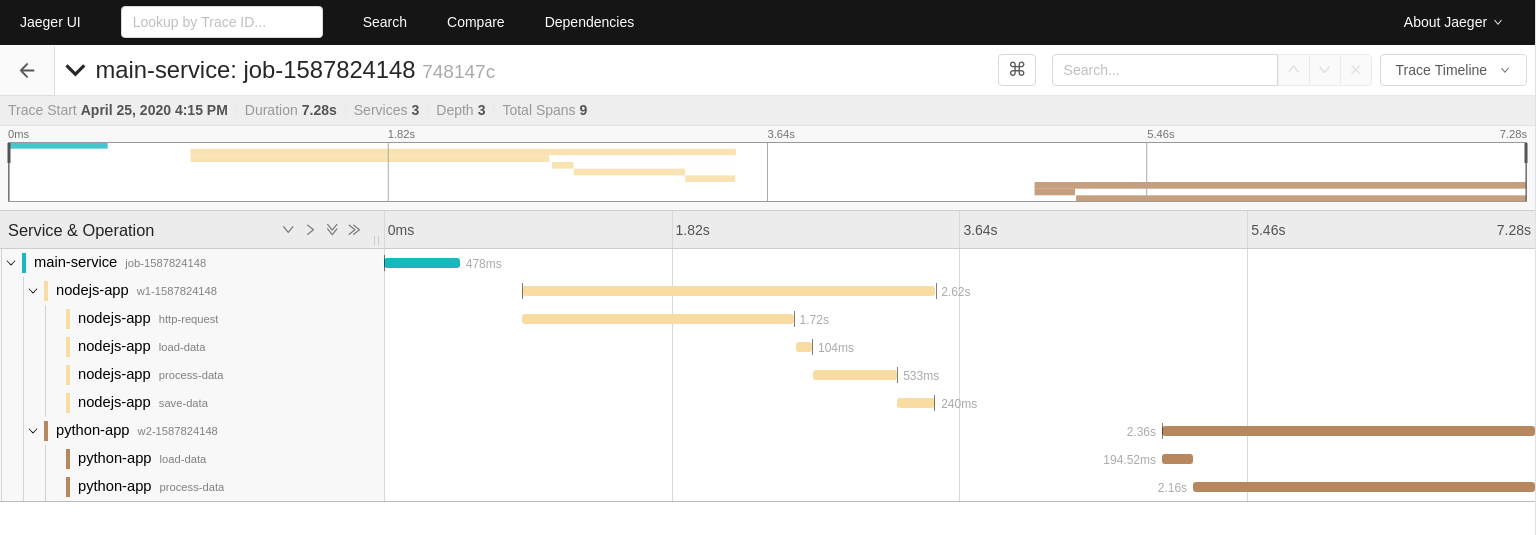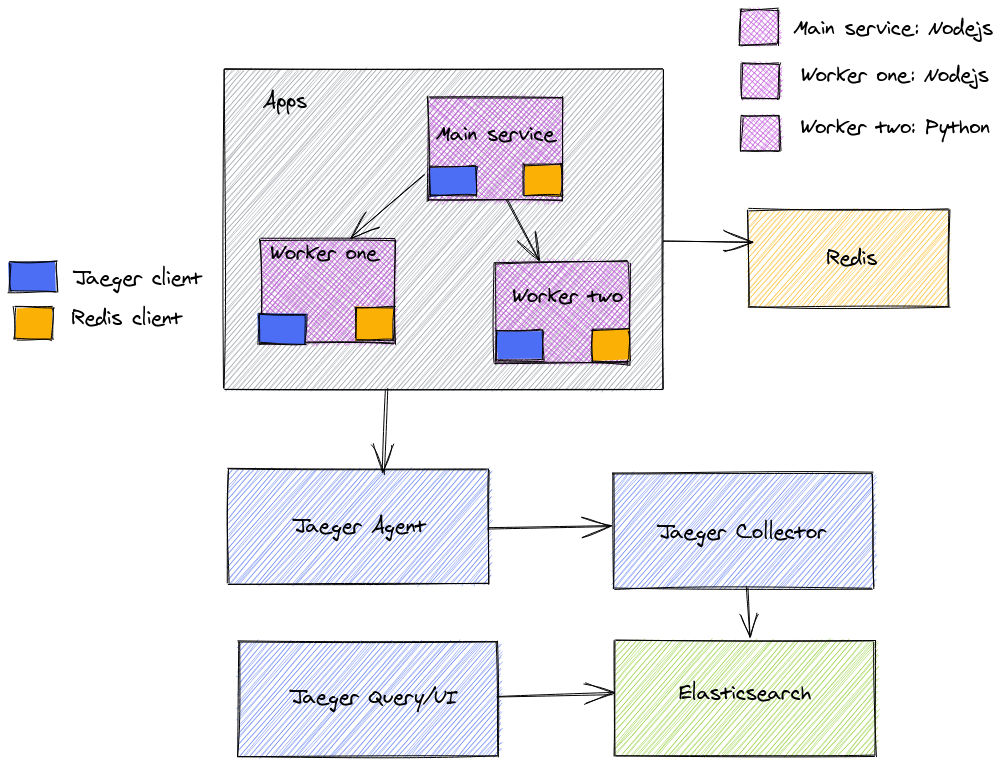An example of distributed tracing with Redis as message queue for propagate the context.
[TODO]
- Docker compose 1.25.4
- GNU/Linux
-
Clone the repo and open the root folder
-
Start all microservices with the command:
docker-compose -f docker-compose.yml up -d --build -
Visit http://localhost:16686 to view traces
The system is composed by the follow modules:
- Apps (that contains two NodeJS apps and a Phyton app)
- Redis
- Jaeger Agent
- Jaeger Collector
- Jaeger Query/UI
- Elasticsearch
Each module is deployed by a docker container through a docker-compose.
As described above, the 3 apps: main-service, worker-one and worker-two use Redis to pass the span context.
The context is saved in Redis using a job-id as key.
At startup the main-service creates a new span and saves the context it in Redis.
/* apps/nodejs-src/app.js */
const jobId = Math.floor(new Date() / 1000)
const mainSpan = await tracer.createSpan(`job-${jobId}`)
...
await tracer.saveContext(jobId, mainSpan.context())
/* apps/nodejs-src/tracer.js */
saveContext(id, context) {
return new Promise((resolve, reject) => {
var map = {}
this.tracer.inject(context, opentracing.FORMAT_TEXT_MAP, map)
redis.set(id, JSON.stringify(map), (err) => {
if (err) { reject(err) }
resolve()
})
})
}
Then it executes the 2 workers launching them through two separated shell commands.
/* apps/nodejs-src/app.js */
async function taskOne(jobId) {
await runCommand(`node /usr/src/nodejs-app/worker.js ${jobId}`)
}
async function taskTwo(jobId) {
await runCommand(`python3 /usr/src/python-app/worker.py ${jobId}`)
}
The two workers receive in input just a job-id, but not the context span, that is retrieved through Redis instead.
Below the code used from the two apps to read the span context from Redis.
Worker-one (NodeJS code)
/* apps/nodejs-src/tracer.js */
async createContinuationSpan(spanName, contextId) {
return this.createSpan(
spanName,
this.extractSpan(await this.loadContext(contextId))
)
}
extractSpan(context) {
if (context) {
return this.tracer.extract(opentracing.FORMAT_TEXT_MAP, context)
}
return undefined
}
loadContext(id) {
return new Promise((resolve, reject) => {
if (!id) resolve(undefined)
redis.get(id, (err, reply) => {
if (err) {
reject(err)
}
if (reply) {
resolve(JSON.parse(reply.toString()))
} else {
resolve(undefined)
}
})
})
}
Worker-two (Python code)
def create_continuation_span(self, span_name, context_id):
return self.create_span(
span_name,
self.extract_span(self.load_context(context_id))
)
def load_context(self, id):
if id is None:
return None
print('id: {}'.format(id) )
byte = self.redis_cli.get(id)
if byte is None:
return None
try:
context = json.loads(byte.decode("utf-8"))
except Exception as e:
return e
return context
def extract_span(self, context):
if (context is None):
return None
return self.tracer.extract(
format=Format.TEXT_MAP,
carrier=context
)
[TODO]
Below some examples of a trasaction and a trace generated by the 3 apps.



- https://medium.com/swlh/microservices-observability-with-distributed-tracing-32ae467bb72a
- https://medium.com/@codeboten/redis-tributed-distributed-tracing-through-redis-9b671187da47
- https://medium.com/opentracing/announcing-python-opentracing-2-0-0-release-f4ee33de25ce
- https://www.jaegertracing.io/docs/1.17/client-libraries/
- https://github.com/jaegertracing/jaeger-client-python
- https://github.com/jaegertracing/jaeger-client-node
- https://opentracing-python.readthedocs.io/en/latest/api.html
- https://opentracing.io/guides/javascript/
- https://opentracing.io/docs/overview/tags-logs-baggage/
- https://github.com/opentracing/opentracing-python
- https://github.com/yurishkuro/opentracing-tutorial/tree/master/python/lesson01
- https://opentracing.io/docs/overview/spans/
- https://opentracing.io/guides/python/tracers/

